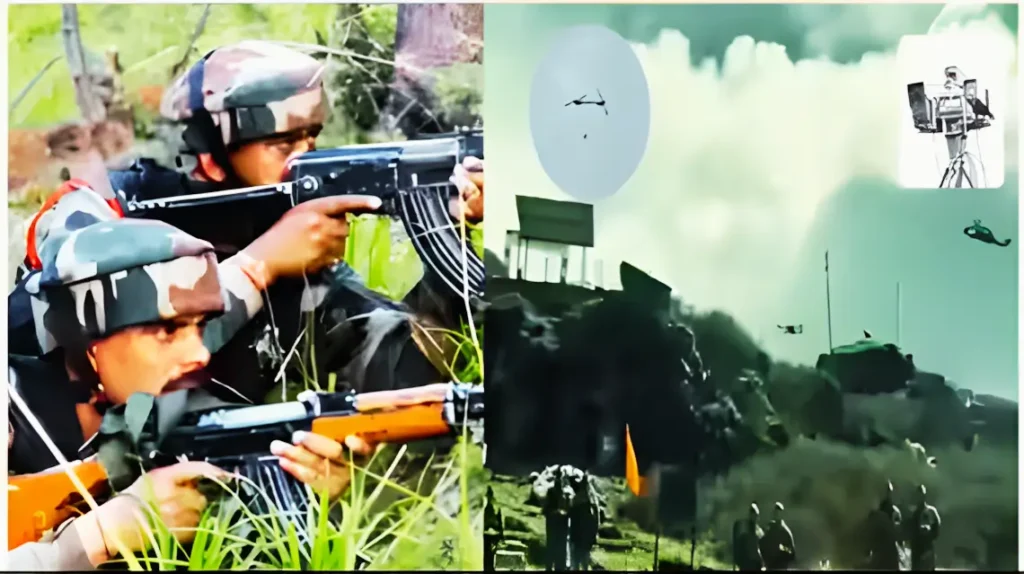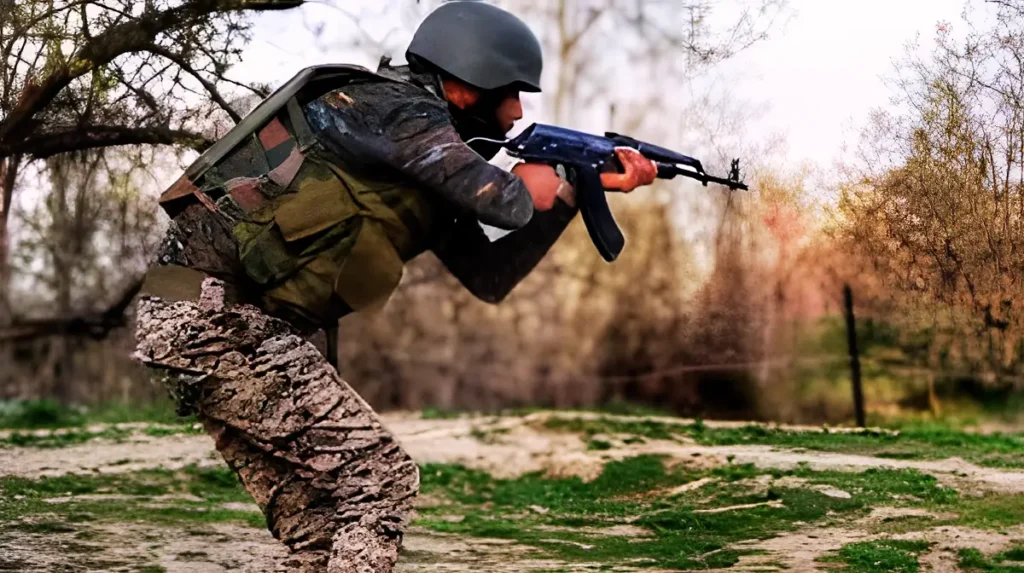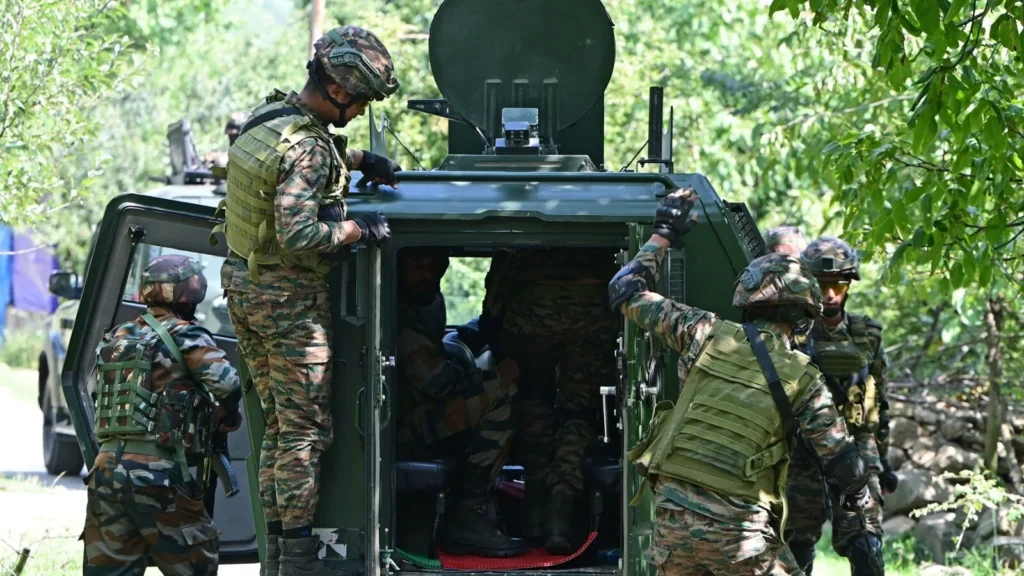In April 2025, a devastating terror strike shook the serenity of Pahalgam, Jammu and Kashmir—leaving the entire nation in mourning. The assault targeted both civilians and security personnel, leaving behind a trail of casualties, grief, and anger. As the country mourned, a swift and strategic counterterrorism mission was launched—Operation Mahadev—a high-stakes response that quickly captured national attention. This spiritual and symbolic connection reminds one of stories like Mahavatar Narsimha‘s divine intervention.

What Happened in Pahalgam?
On April 22, 2025, heavily armed terrorists ambushed a bustling area near Pahalgam, a popular destination especially during the sacred Sawan season. The timing was deliberate and sinister, as thousands of Hindu pilgrims travel through the region during this time. The attackers, reportedly linked to a locally embedded module backed by foreign handlers, unleashed chaos, killing and injuring several innocent people.
The Pahalgam attack was not just an act of terror—it was a direct assault on the unity, faith, and peace of the region. Public outrage surged across the country, prompting urgent questions about intelligence failures, security preparedness, and the continued threat of militancy in the Kashmir Valley.
Why Operation Mahadev Was Launched
The sheer scale and symbolic timing of the attack demanded an immediate and forceful response. Intelligence agencies soon uncovered chilling plans: the same terror module was preparing additional attacks targeting civilians and security installations across South Kashmir. The government acted swiftly to prevent further bloodshed.
This critical mission was codenamed “Operation Mahadev”, drawing spiritual strength from Lord Shiva, a deeply revered deity, especially during the Sawan pilgrimage season. The name carried emotional weight—it wasn’t just about eliminating terrorists, but about restoring peace, faith, and the collective morale of the nation.
Intelligence Gathering and Execution
Operation Mahadev was built on precision intelligence. Surveillance teams intercepted communications, tapped into local informant networks, and used drones and satellite imagery to track the militants’ movements. The breakthrough came when actionable intelligence pinpointed the location of the perpetrators—near Dachigam National Park, just outside Srinagar.
Security forces identified the mastermind as either Suleiman Shah or Hashim Musa, both infamous for planning multiple terror operations in the region. A joint task force comprising the Indian Army, CRPF, and Jammu and Kashmir Police was mobilized. Over several tense hours, they launched a coordinated strike.
The mission was a resounding success. Three terrorists were neutralized, including the mastermind behind the Pahalgam carnage. No civilian casualties were reported during the operation, reflecting the precision and professionalism of the forces involved.
Why Operation Mahadev Matters
Beyond tactical success, Operation Mahadev represented a moment of resilience and unity. It signified India’s unyielding stance against terrorism and the evolution of its counterinsurgency capabilities. The operation also demonstrated the high level of coordination between intelligence agencies and ground forces, ensuring swift justice for the victims and deterrence against future attacks.
As the smoke cleared, Operation Mahadev stood as a powerful reminder that while terrorists may strike, they cannot break the spirit of a nation that stands united—armed with faith, courage, and the will to protect its people.

Operation Mahadev: Timeline, Key Facts & Strategic Impact of India’s Swift Counter-Terror Mission
Operation Mahadev was a rapid and intelligence-driven counter-terrorism mission launched in response to the brutal Pahalgam attack on April 22, 2025. The operation not only neutralized the key perpetrators but also symbolized India’s unwavering resolve against terrorism. Here’s a detailed look at the timeline, key facts, and the broader significance of Operation Mahadev.
🔹 Timeline of Operation Mahadev
🗓️ April 22, 2025
A horrifying terror attack rocked Pahalgam, claiming the lives of multiple civilians and security personnel. The incident triggered nationwide outrage and an urgent call for justice.
🗓️ April 23 – July 26, 2025
A multi-agency intelligence effort began immediately. Technical surveillance including satellite phone intercepts, drone recon, and inputs from ground operatives led security forces to a location near Dachigam National Park, on the outskirts of Srinagar.
🗓️ July 27, 2025
Movement resembling that of the suspects, including top militant Suleiman Shah alias Hashim Musa, was detected. The Indian Army, CRPF, and Jammu & Kashmir Police came together to plan a precise joint strike under the codename: Operation Mahadev.
🗓️ Early Morning, July 28, 2025
The operation commenced with surgical precision. Security forces cordoned off the hideout, resulting in a fierce but short gunbattle.
🗓️ By Noon, July 28, 2025
Within just three hours, all three militants—including Suleiman Shah, the presumed mastermind of the Pahalgam attack—were eliminated. Operation Mahadev was declared a complete success.
🔹 Key Facts About Operation Mahadev
- ✅ Speed & Precision: From final surveillance confirmation to mission completion, Operation Mahadev lasted less than three hours.
- ✅ Unified Strike Force: The seamless coordination between the Indian Army, CRPF, and J&K Police was critical in the mission’s success.
- ✅ Tech-Driven Success: The interception of a Chinese satellite phone, among other intel sources, played a pivotal role in locating the terrorists.
- ✅ Symbolic Timing: The operation took place during the sacred Sawan pilgrimage, giving the name “Operation Mahadev” a deeper emotional and cultural resonance.
- ✅ Strategic Win: Eliminating Suleiman Shah dealt a significant blow to the local terror networks and restored morale among both civilians and armed forces.
🔹 Why Operation Mahadev Matters
More than just a tactical operation, Operation Mahadev stands as a symbol of India’s sharpened intelligence capabilities, quick mobilization, and no-tolerance stance against terrorism. The operation’s success has set a benchmark in modern counter-terror strategy, reaffirming that justice will be swift and certain.
Heroism & Tribute: The Faces Behind Operation Mahadev
Operation Mahadev

🔹 Units Behind Operation Mahadev
Indian Army (Rashtriya Rifles / Para Commandos)
The spearhead of Operation Mahadev, the Army’s elite RR and Para Commando units led the direct assault. Their mastery in mountain warfare, particularly in navigating the rugged Dachigam terrain, enabled them to corner and eliminate the militants with clinical precision. The final strike was executed with minimal collateral damage, thanks to their tactical discipline.
CRPF (Central Reserve Police Force)
CRPF’s Quick Action Teams provided essential cordon and containment support. They sealed off potential escape routes and ensured total isolation of the target zone. Their role in synchronizing perimeter control with the Army’s forward push was crucial to preventing any breach during the high-stakes encounter.
Jammu & Kashmir Police
Local intelligence was the bedrock of Operation Mahadev’s planning. JK Police leveraged community networks to track fugitive movement, aiding the precision of the strike. Their regional knowledge allowed forces to operate with accuracy and restraint, avoiding civilian harm while closing in on the suspects.
🔹 Stories of Heroism
Incredible bravery defined the operation. One standout figure is Lieutenant Arjun Singh, a junior officer from the RR, who advanced under hostile fire and laid down suppressive cover to allow flanking units to maneuver. His leadership under pressure proved decisive.
Another story of gallantry came from CRPF Head Constable Sanjay Rawat, who, despite being injured by shrapnel, shielded a fallen comrade and refused evacuation until the operation concluded.
Even among the J&K Police, Sub-Inspector Nazir Lone suffered a gunshot wound while evacuating local guides. His actions potentially saved civilian lives during a volatile encounter.
🔹 Injuries and Sacrifices
Though the mission was successful, it was not without cost. At least three personnel sustained injuries, including gunshots and splinter wounds. Yet, thanks to excellent planning and real-time coordination, no fatalities were reported among the security forces—an incredible achievement in such a high-risk operation.
Symbolism & Cultural Resonance: Why “Operation Mahadev”?
The name Operation Mahadev was a powerful choice, evoking the divine protector Lord Shiva—the destroyer of evil in Hindu mythology. It carried spiritual weight, especially since the mission occurred during the sacred Sawan month, when Shiva devotees undertake pilgrimages like the Amarnath Yatra in Kashmir.
By invoking “Mahadev,” the operation was seen not just as a military retaliation, but as a moral and spiritual statement: a declaration that good will always rise against evil. For many across India, especially in North India and Jammu & Kashmir, the name stirred a deep emotional connection.
Social media platforms were flooded with tributes, artwork, and praise, comparing the soldiers to Shiva’s own warriors—vanquishers of darkness. Pilgrims, locals, and the families of victims viewed the operation as divine justice delivered through human hands.
Impact & Morale: Operation Mahadev and Its Ripple Effects
Operation Mahadev was not just a military maneuver—it was a defining moment in the emotional and social landscape of Jammu and Kashmir. The operation’s aftermath touched countless lives, restored shaken faith, and shifted the momentum in India’s fight against terror.
🔹 Family Situation of Victims
The Pahalgam terror attack left behind a trail of grief and irreparable loss. Families of the victims—many of whom were primary earners—found themselves in emotional and financial turmoil. Children were orphaned, elderly parents left helpless, and entire households thrown into despair.
However, the swiftness and decisiveness of Operation Mahadev offered these families a rare form of closure. Government agencies and NGOs stepped in with relief packages, psychological counseling, and educational support for the victims’ children. In several media interviews, grieving relatives expressed both sorrow and gratitude—sorrow for their loss, and gratitude for the justice delivered through the elimination of the attackers, especially the dreaded mastermind.
🔹 Morale of the Local Population
In the days following Operation Mahadev, a visible shift in public sentiment emerged across South Kashmir. Markets reopened, pilgrim routes resumed, and a renewed sense of normalcy took hold. Locals who had grown desensitized to violence found renewed trust in security forces.
Community leaders noted that youth morale, especially among those on the edge of radical influence, had improved. The operation was seen as proof that terrorism is not invincible, and that working with authorities could yield meaningful results. The quick and clean execution of the mission sent a clear deterrent message—violence would be answered with precision and force.
🔹 Broader Strategic Impact in Kashmir
From a counterterrorism perspective, Operation Mahadev marked a significant milestone. It dismantled a well-coordinated terror module that had intended to fuel more chaos during the holy Sawan season.
More importantly, the operation showcased a refined counterterror model—intelligence-led, inter-agency synchronized, and emotionally resonant with the people. Analysts observed that in the weeks following the operation:
- Online militant propaganda and recruitment dropped sharply.
- Digital chatter revealed nervousness within remaining modules.
- Civilian tip-offs to security forces increased, indicating higher public cooperation.
This was more than retribution—it was a statement that India’s security ecosystem has evolved, and so has public will to fight terror.

Social Media Reactions to Operation Mahadev
In today’s digital world, public sentiment is often shaped and reflected online. Operation Mahadev captured the collective attention of India’s social media like few counterterror missions ever have.
Memorial posts flooded timelines. Custom profile frames reading “Victory for Mahadev” went viral. Pages dedicated to security forces shared images of soldiers, saluting their bravery. Videos showing Army and police flags fluttering together in Dachigam received thousands of emotional comments.
🐦 X (Twitter)
Hashtags like #OperationMahadev, #JusticeForPahalgam, and #JaiMahadev trended for 48 hours. Celebrities, politicians, and civilians alike expressed support, pride, and calls for unity. Many highlighted the symbolic naming of the operation during Sawan as a powerful spiritual stand against evil.
📺 YouTube
Explainer videos detailing the tactical aspects of the mission, background of the terrorists, and the cultural symbolism of “Mahadev” collectively garnered millions of views. Heartwarming shorts featuring elderly locals blessing soldiers became viral hits.
😂 Memes and Trends
Meme creators joined in, visualizing Lord Shiva’s trident striking down terror or drawing contrasts between India’s planning and terrorist blunders. Even humorous takes reinforced public pride and morale.
❤️ Emotional Content
Perhaps most powerful were the emotional reels and shorts showing children of Pahalgam victims celebrating the victory, smiling through their pain, knowing their loss was not in vain. These clips struck deep emotional chords and rekindled national unity.
Operation Sindoor vs. Operation Mahadev: A Comparative Lens
| Aspect | Operation Sindoor | Operation Mahadev |
| Trigger Event | Convoy attack; security casualties | Civilian attack during sacred Sawan pilgrimage |
| Units Involved | Army (RR), J&K Police (STF) | Army (RR/Para), CRPF, J&K Police |
| Symbolism in Name | “Sindoor” – Symbol of protection and marital sanctity | “Mahadev” – Shiva; destroyer of evil and protector |
| Timing | Winter; off-season | Sawan; peak pilgrimage and high religious sentiment |
| Strategy | Traditional, multi-day combing | Precision, intelligence-led, technical surveillance-based |
| Collateral Damage | Higher casualties and injuries | Minimal; surgical execution with civilian safety ensured |
| Social Impact | Rebuilt public trust gradually | Emotionally unifying; surge in morale and national pride |
🔍 What Sets Operation Mahadev Apart?
While Operation Sindoor reaffirmed operational capabilities, Operation Mahadev fused precision warfare with symbolic power. It not only neutralized a threat but emotionally empowered a region. The cultural timing, spiritual naming, rapid execution, and public backing gave it an almost mythic stature in the eyes of the nation.
In a land often torn between faith, fear, and frustration, Operation Mahadev proved that justice, when swift and righteous, can heal wounds and ignite hope.
Conclusion: A Legacy of Courage and Unity
Operation Mahadev stands as a powerful reminder of what unified, intelligent, and brave action can achieve. It was not just a counter-terror win—it was a symbol of national resilience, cultural reverence, and the unbreakable will of India’s security forces.
From the forested valleys of Dachigam to the screens of social media, the legacy of Operation Mahadev continues to echo—a righteous blow to terror, a tribute to the fallen, and a reassurance to the nation. To explore more perspectives on courage and emotional resilience, you might also enjoy reading: Saiyaara – A Story That Heals
Personal Opinion / Op-Ed
It wasn’t just a military operation. It felt like divine justice in motion—as if Mahadev Himself was watching over His devotees during Sawan. As someone who is deeply devoted to Him, I couldn’t ignore the spiritual symbolism—“Operation Mahadev” didn’t just eliminate terror threats, it reminded us that faith and courage walk hand in hand. During a month when devotees chant His name, it’s no coincidence that justice unfolded with such force. It felt like a message—that no evil can thrive under the gaze of the Lord of Destruction.
